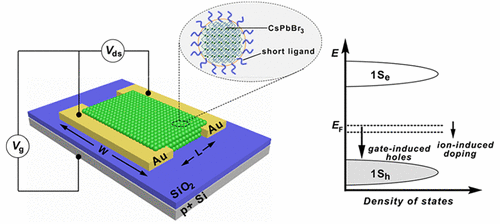当前位置:
X-MOL 学术
›
ACS Energy Lett.
›
论文详情
Our official English website, www.x-mol.net, welcomes your
feedback! (Note: you will need to create a separate account there.)
Understanding Charge Transport in All-Inorganic Halide Perovskite Nanocrystal Thin-Film Field Effect Transistors
ACS Energy Letters ( IF 19.3 ) Pub Date : 2020-07-20 , DOI: 10.1021/acsenergylett.0c01295 Shu Zhou, Guodong Zhou, Yuhao Li, Xin Xu, Yao-Jane Hsu, Jianbin Xu, Ni Zhao, Xinhui Lu
ACS Energy Letters ( IF 19.3 ) Pub Date : 2020-07-20 , DOI: 10.1021/acsenergylett.0c01295 Shu Zhou, Guodong Zhou, Yuhao Li, Xin Xu, Yao-Jane Hsu, Jianbin Xu, Ni Zhao, Xinhui Lu

|
Improving devices based on solution-processed halide perovskite nanocrystals (NCs) demands a deeper understanding of charge transport in this emerging new class of ionic semiconductor nanomaterials. In this work, we fabricate all-inorganic CsPbBr3 NCs terminated with short ligands into field effect transistors, providing a facile platform to study the electronic–ionic transport systematically. By combining with transient response characterization, we demonstrate that electronic current is the dominant current passing through perovskite-NC films under dark conditions, while mobile ions induce intrinsic doping to perovskite NCs, which gradually changes the film conductivity and thereby the magnitude of the electronic current. The ion-induced doping prevails over the gating effect at room temperature, resulting in no gate modulation of the channel current in the transistor measurements. At T < 240 K, however, when ionic transport is suppressed, CsPbBr3-NC transistors exhibit a clean unipolar transport characteristic in a p-type mode featuring well-defined linear and saturation regimes. Extrinsically Bi3+- and Ag+-doped CsPbBr3-NC films further confirm the p-type transport property and dominant electrical gating effect at low temperature, which enables switching the device from normally off (p-type enhancement) to normally on (p-type depletion).
中文翻译:

了解全无机卤化物钙钛矿纳米晶体薄膜场效应晶体管中的电荷传输
基于溶液处理的卤化物钙钛矿纳米晶体(NCs)的改进设备要求在这种新兴的新型离子半导体纳米材料中对电荷传输有更深入的了解。在这项工作中,我们制造了全无机CsPbBr 3NC以短配体终止于场效应晶体管,为系统地研究电子-离子迁移提供了一个便捷的平台。通过结合瞬态响应特性,我们证明了电子电流是在黑暗条件下通过钙钛矿-NC膜的主导电流,而移动离子诱导对钙钛矿NCs的固有掺杂,从而逐渐改变了膜的电导率,从而改变了电子电流的大小。 。在室温下,离子诱导的掺杂胜过栅极效应,导致晶体管测量中的沟道电流没有栅极调制。然而,在T <240 K时,当抑制离子传输时,CsPbBr 3 -NC晶体管在电导率中表现出纯净的单极传输特性。p型模式具有明确的线性和饱和状态。外源性地掺杂Bi 3+和Ag +的CsPbBr 3 -NC薄膜进一步证实了p型传输性质和主要的电子门控效应,从而在低温下将器件从常关(p型增强)切换为常开(p型耗尽)。
更新日期:2020-08-14
中文翻译:

了解全无机卤化物钙钛矿纳米晶体薄膜场效应晶体管中的电荷传输
基于溶液处理的卤化物钙钛矿纳米晶体(NCs)的改进设备要求在这种新兴的新型离子半导体纳米材料中对电荷传输有更深入的了解。在这项工作中,我们制造了全无机CsPbBr 3NC以短配体终止于场效应晶体管,为系统地研究电子-离子迁移提供了一个便捷的平台。通过结合瞬态响应特性,我们证明了电子电流是在黑暗条件下通过钙钛矿-NC膜的主导电流,而移动离子诱导对钙钛矿NCs的固有掺杂,从而逐渐改变了膜的电导率,从而改变了电子电流的大小。 。在室温下,离子诱导的掺杂胜过栅极效应,导致晶体管测量中的沟道电流没有栅极调制。然而,在T <240 K时,当抑制离子传输时,CsPbBr 3 -NC晶体管在电导率中表现出纯净的单极传输特性。p型模式具有明确的线性和饱和状态。外源性地掺杂Bi 3+和Ag +的CsPbBr 3 -NC薄膜进一步证实了p型传输性质和主要的电子门控效应,从而在低温下将器件从常关(p型增强)切换为常开(p型耗尽)。































 京公网安备 11010802027423号
京公网安备 11010802027423号